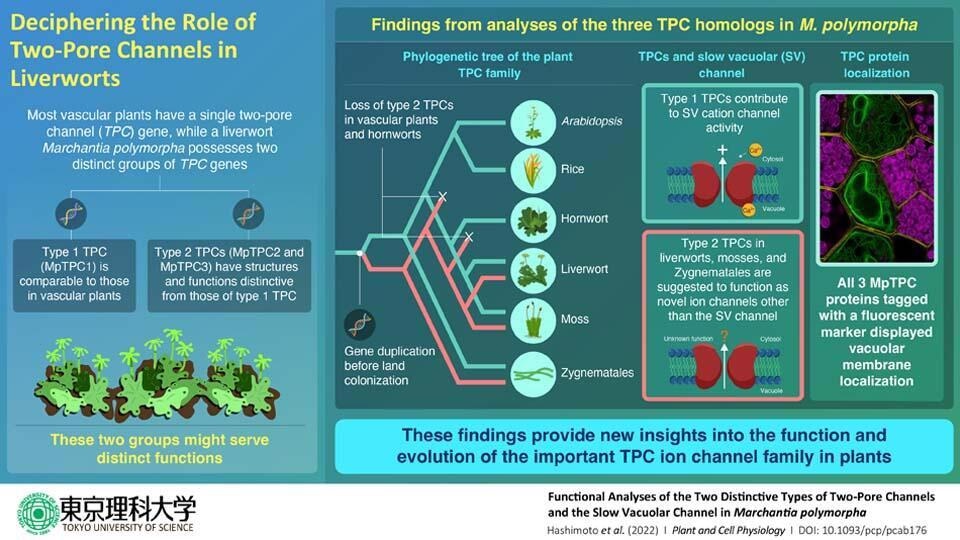TPCs (two-pore channels) are old ion channels found in both animal and plant cells. These ion channels serve key roles in biological activity in numerous tissues in animals, including humans, like the brain and nervous system.
 Functional Analyses of the Two Distinctive Types of Two-Pore Channels and the Slow Vacuolar Channel in Marchantia polymorpha. Image Credit: Hashimoto, K., et al. Plant and Cell Physiology
Functional Analyses of the Two Distinctive Types of Two-Pore Channels and the Slow Vacuolar Channel in Marchantia polymorpha. Image Credit: Hashimoto, K., et al. Plant and Cell Physiology
TPC genes are found in all land plant species, and a single TPC gene is engaged in the operation of slow vacuolar (SV) channels (voltage-dependent cation channels) as well as long-distance signaling, defense, and responses to environmental stress in many greater vascular plants like Arabidopsis thaliana (Arabidopsis) and Oryza sativa (rice).
However, very little is understood about TPC protein activity in non-flowering mosses and liverworts, which are among the Earth’s oldest creatures.
In a recent analysis, researchers from Tokyo University of Science and Maria Curie-Sklodowska University in Poland collaborated to investigate the developmental and physiological importance of two-pore channels in the non-flowering bryophyte Marchantia polymorpha.
Their widely acclaimed and well-received article, which delves into the details of this investigation, was first published online in December 2021 and then in print in the February issue of Plant and Cell Physiology.
The journal has recognized the paper as an “Editor’s Choice” and “Research Highlight” article and has issued a commentary regarding the study here. A grant from the Japanese Society for the Promotion of Science and the National Science Centre in Poland provided financing for this study.
M. polymorpha, often known as common liverwort, is an existing descendent from one of the first plants to inhabit the land, growing as thin, flat green sheets on moist soil or rock. M. polymorpha is a basic model organism that has been used to study common terrestrial plant properties.
We realized that the genome of M. polymorpha has three TPC homologs: MpTPC1, 2, and 3, belonging to two distinctive groups, type 1 and type 2 TPC genes. We aimed to know what these two subgroups of TPC proteins do in M. polymorpha.”
Kazuyuki Kuchitsu, Professor, Tokyo University of Science
The scientists began by doing a phylogenetic analysis of TPC genes in the green plant lineage. The three TPC proteins, MpTPC1 from the Type 1 TPC gene and MpTPC2 and MpTPC3 from the Type 2 TPC gene, were then characterized. Researchers examined the location of these proteins in M. polymorpha cells by tagging them with a fluorescent marker.
The researchers used CRISPR-Cas9 genome editing to create mutant plants that lacked functional TPC1, TPC2, or TPC3 genes, as well as double mutant plants that lacked both TPC2 and TPC3 gene functions. They next used patch-clamp electrophysiology to quantify ionic currents in isolated vacuoles from M. polymorpha plants’ live cells.
The outcomes of the phylogenetic studies delivered some fascinating understandings of the evolutionary history of M. polymorpha.
Unlike the type 1 TPC gene, which is well conserved in all land plants, type 2 TPCs were found in algal species. This suggested that although the type 2 TPCs emerged before plants colonized the land, they failed to make their way into the genome of higher vascular plants and hornworts.”
Kazuyuki Kuchitsu, Professor, Tokyo University of Science
The three TPC proteins were discovered to be primarily localized at the vacuolar membrane of M. polymorpha, according to the researchers. SV channel activity was absent in the mutant lacking a functioning TPC1 gene. Mutants lacking functioning TPC2, TPC3, or both, on the other hand, showed normal SV channel activity.
Molecules that activate TPCs in mammalian cells, like phosphatidylinositol-3, 5-bisphosphate, and nicotinic acid adenine dinucleotide phosphate, did not affect ion channel function in isolated vacuoles of mutant plants.
These observations, when tied down together, indicated that the type 1 TPCs-which are ubiquitous in all land plant species-are responsible for SV channels in their vacuolar membrane, but the type 2 TPCs likely encode ion channels that are different from the SV channel and animal TPCs.”
Kazuyuki Kuchitsu, Professor, Tokyo University of Science
The results provided a crucial functional and developmental understanding of the important but enigmatic TPC family of plant ion channels, as well as plant ion channels in particular. They also hope to apply insights from plant evolutionary history to improve plant growth and defense systems against biotic and abiotic challenges in future studies. This could benefit a variety of businesses, including agriculture.
Source:
Journal reference:
Hashimoto, K., et al. (2022) Functional Analyses of the Two Distinctive Types of Two-Pore Channels and the Slow Vacuolar Channel in Marchantia polymorpha. Plant and Cell Physiology. doi.org/10.1093/pcp/pcab176.